Strength Training for Runners (Top 19 Workout Exercises)
Every runner’s favorite activity is running. We want to run as many miles as possible and be as fast as possible.
Alongside our daily responsibilities and tight schedule, we would rather run five more miles than do a strength workout.
And so, as we focus solely on the miles, we forget that what is necessary to run in the first place.
In this article, I will show you the top 19 strength exercises for runners and give you 2 examples of strength workouts.
Strength exercises for runners
In addition to preventing injury, strength exercises will also help you build the muscles needed to maintain proper running form and therefore run more efficiently.
While performing each exercise, it is important to focus on proper form.
If you aren’t able to do an exercise properly, shorten the duration of the exercise and increase the duration of recovery.
Also, focus on breathing. It is important to breathe during the whole exercise to ensure proper oxygen flow.
1. Plank
This exercise activates your core, glutes, quadriceps, and shoulders.
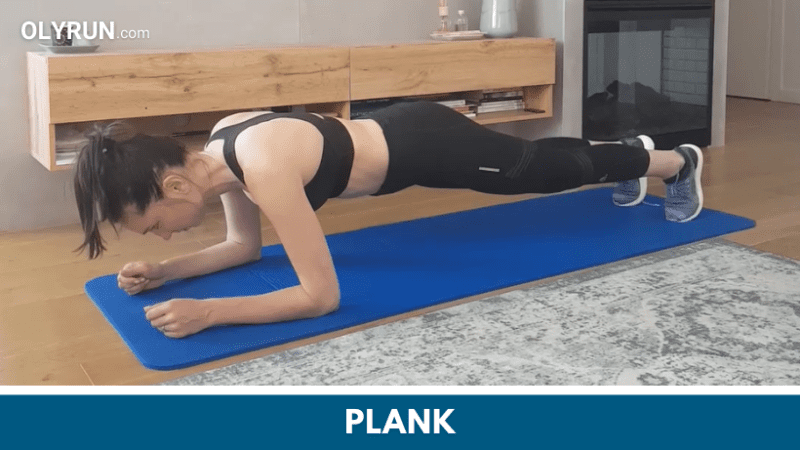
How to properly do a plank?
- Get into the starting position, face down with your elbows and toes on the floor. Your feet are hip-width apart. The elbows are perpendicular to the floor and are right below your shoulders, with the forearms facing forward. Your head, neck, and spine are straight, and you are looking down at the floor.
- Tighten your muscles and hold this position for about 30–60 seconds.
Advice for doing a plank
- Check your posture – keep your spine neutral, and don’t drop your hips or stick your butt in the air.
- Don’t bend your back – if you bend your back, you do not engage your abdominal muscles well enough and you put greater pressure on your arms.
- For an easier version of this exercise, rest on your knees instead of your feet.
2. Side plank
This exercise activates your core, glutes, quadriceps, shoulders, arms, and lower back muscles.
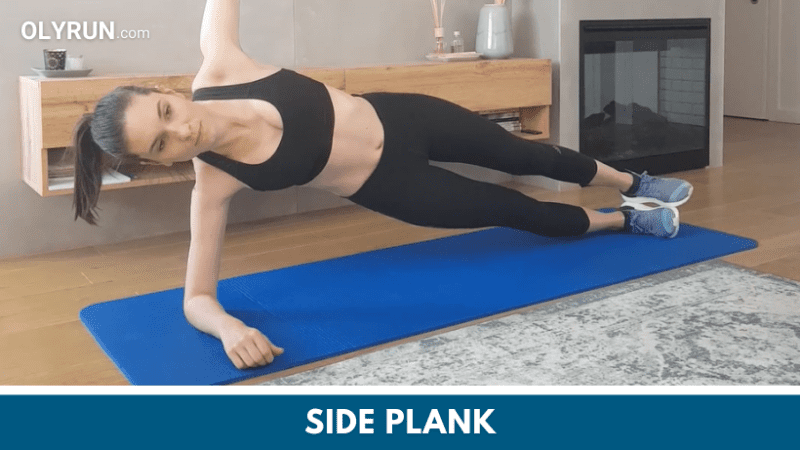
How to properly do a side plank?
- Get into the starting position, with the right forearm and the side of your right foot on the floor. Elbow is perpendicular to the surface and right below your shoulder. Your head, neck, and spine are straight, and you are looking straight ahead.
- Tighten your muscles and hold this position for about 30–60 seconds.
- Repeat the exercise on the other side.
Advice for doing a side plank
- Check your posture – don’t lift or lower your hips and avoid twisting your body.
- For a more difficult version of this exercise, rest on your palm instead of your forearm.
3. Shoulder taps
This exercise activates your core, glutes, quadriceps, shoulders, and arms.
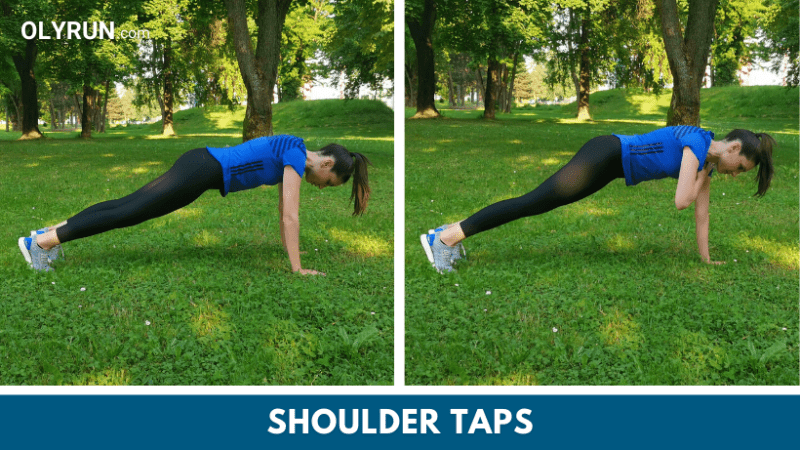
How to properly do shoulder taps?
- Get into the starting position, face down with your palms and toes on the floor. Your feet are hip-width apart. The arms are outstretched at the elbow and are perpendicular to the floor. Your head, neck, and spine are straight, and you are looking down at the floor.
- Touch your left shoulder with your right hand, leaning on the palm of your left hand.
- Return to the starting position.
- Touch your right shoulder with your left hand, leaning on the palm of your right hand.
- Repeat the movement until the end of the exercise.
Advice for doing shoulder taps
- Check your posture – keep your spine neutral, don’t drop your hips, and or stick your butt in the air.
- Keep your hips stable – don’t twist at the hips; hips must be parallel to the floor.
- For an easier version of this exercise, lean on your knees instead of your feet.
4. Push-up
This exercise activates your core, glutes, quadriceps, shoulders, and arms.

How to properly do push-ups?
- Get into the starting position, face down with your palms and toes on the floor. Your feet are hip-width apart. The arms are outstretched at the elbow and are perpendicular to the floor. Your head, neck, and spine are straight, and you are looking down at the floor.
- Lower yourself until your elbows are at the right angle.
- Return to the starting position.
- Repeat the movement until the end of the exercise.
Advice for doing push-ups
- Check your posture – keep your spine neutral, and don’t drop your hips or stick your butt in the air.
- For an easier version of this exercise, lean on your knees instead of your feet.
- For a more difficult version of this exercise, do push-ups with your legs on an elevated surface.
5. Knee-to-elbow
This exercise activates your core, hip flexors, glutes, shoulders, arms, and calf muscles.
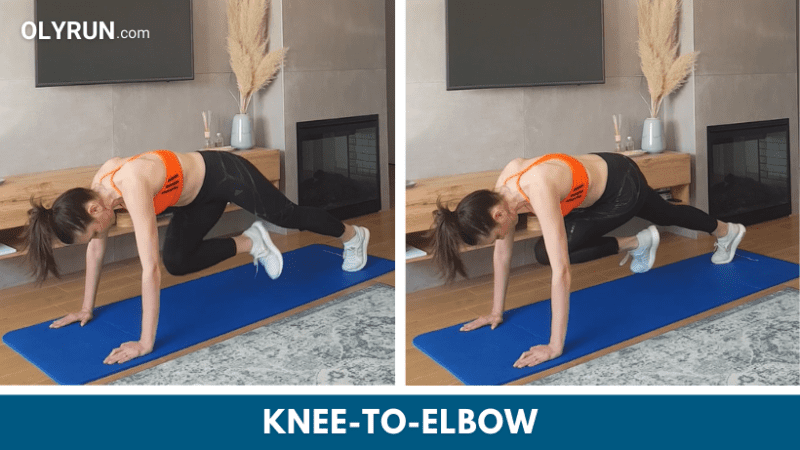
How to properly do the knee-to-elbow exercise?
- Start in a high plank position with arms perpendicular to the floor. Arms and legs are shoulder-width apart.
- Pull the knee of your right leg to the elbow of your left arm.
- Return to the starting plank position.
- Repeat the same movement with your left leg.
- Continue switching sides until the end of the exercise.
Advice for doing the knee-to-elbow exercise
- Check your posture – activate your core; hold your head, neck, and spine in a line; look straight down.
- Focus on breathing – it is important to breathe during the whole exercise to ensure proper oxygen flow.
- Check your form – don’t move too fast so that you can focus on the proper way of performing the exercise.
6. Russian twist
This exercise activates your core and hip flexors.

How to properly do a Russian twist?
- Sit in the starting position so that your knees are bent at a 90-degree angle, slightly lean backward, cross your legs and lift them off the floor so that your upper body and legs form the letter V.
- Rotate your upper body as far to the left as possible.
- Return to the starting position.
- Rotate your upper body as far to the right as possible.
- Continue switching sides until the end of the exercise.
Advice for doing a Russian twist
- For an easier version of this exercise, put your feet on the floor. This will, however, make your abs less engaged.
- For a harder version, take a dumbbell – choose a weight with which you will be able to maintain proper form.
- Check your posture – your spine should be as straight as possible, do not bend it, and let your gaze follow the movement of your arms.
- Focus on breathing – it is important to breathe during the whole exercise to ensure proper oxygen flow.
7. Knees-to-chest
This exercise activates your core and hip flexors.

How to properly do the knees-to-chest exercise?
- Lie on your back in the starting position, with your arms at your sides and legs outstretched.
- Pull both knees to your chest.
- Extend your legs without touching the floor.
- Repeat the same movement until the end of the exercise.
Advice for doing the knees-to-chest exercise
- For an easier version of this exercise, extend your legs and touch the floor, doing the exercise slowly.
- Focus on breathing – it is important to breathe during the whole exercise to ensure proper oxygen flow.
- Maintain balance with your arms.
- Check your form – don’t move too fast so that you can focus on the proper way of performing the exercise.
8. Heel touches
This exercise activates your core.
How to properly do heel touches?
- Get into the starting position, face up with your back and feet flat on the floor.
- Touch the heel of your right foot with your right hand.
- Touch the heel of your left foot with your left hand.
- Repeat the movement until the end of the exercise.
Advice for doing heel touches
- Check your form – don’t move too fast so that you can focus on the proper way of doing the exercise.
9. Bird dog
This exercise activates your glutes, core, shoulders, arms, and lower back muscles.
How to properly do the bird dog exercise?
- Get into the starting position, on your knees with your palms on the floor, looking down. The arms are outstretched. Your head, neck, and spine are straight, and you are looking down at the floor.
- Lift your outstretched left arm and right leg so that they are aligned with your spine.
- Return to the starting position.
- Repeat the movement until the end of the exercise.
- Repeat the exercise on the other side.
Advice for doing the bird dog exercise
- Check your posture – keep your spine neutral, and don’t drop your hips or stick your butt in the air.
- Don’t bend your lifted arms and legs – the lifted arm and leg must be outstretched.
- Don’t forget to breathe – although you’re facing the floor, it is important to breathe during the whole exercise to ensure proper oxygen flow to the muscles.
- Movement should be controlled.
- For a more difficult version of this exercise, perform the exercise on an uneven surface or add weight to your arms and legs.
10. Superman
This exercise activates your glutes, core, shoulders, arms, and upper back muscles.
How to properly do the superman exercise?
- Get into the starting position, lying on your stomach, face down with arms outstretched and legs aligned with your hips. Your head, neck, and spine are straight, and you are looking down at the floor.
- Lift your outstretched arms and legs off the floor and hold this position for about 30–60 seconds.
Advice for doing the superman exercise
- Check your posture – don’t let your arms and legs touch the floor.
- Don’t bend your arms and legs – arms and legs must be outstretched.
- Don’t forget to breathe – although you’re facing the floor, it is important to breathe during the whole exercise to ensure proper oxygen flow to the muscles.
11. Bridge
This exercise activates your core, glutes, and hamstrings.

How to properly do the bridge exercise?
- Get into the starting position, face up with shoulders and feet on the floor. Legs are slightly bent at the knee at right angles and are hip-width apart. You are looking up.
- Tighten your muscles and hold this position for about 30–60 seconds.
Advice for doing the bridge exercise
- Check your form – don’t drop your hips.
- For a more difficult version of this exercise, add weight onto your hips or use an elastic band.
12. Single-leg deadlift
This exercise activates your quadriceps, hamstrings, glutes, and core.

How to properly do single-leg deadlifts?
- Stand in the starting position so that your feet are hip-width apart, look straight ahead, and keep your upper body straight.
- Standing with your right foot flat on the floor, lift your left leg behind you, and lower your upper body forward until your left leg and your body are parallel to the floor. Your head, neck, and spine are straight, and you are looking down at the floor.
- Return to the starting position.
- Repeat the movement until the end of the exercise.
- Repeat the exercise on the other side.
Advice for doing single-leg deadlifts
- Check your posture – keep your spine neutral, and don’t drop your hips or stick your butt in the air.
- Don’t bend your lifted arms and legs – the lifted arm and leg must be outstretched.
- Don’t forget to breathe – although you’re facing the floor, it is important to breathe during the whole exercise to ensure proper oxygen flow to the muscles.
- Movement should be controlled.
- For a more difficult version of this exercise, perform the exercise on an uneven surface or add weight to your arms and legs.
13. Squat
This exercise activates your quadriceps, hamstrings, glutes, core, and calf muscles.

How to properly do squats?
- Stand in the starting position so that your feet are hip-width apart, look straight ahead, and keep your upper body straight.
- Lower yourself to a half-squat position so that your thighs are parallel to the floor.
- Return to the starting position.
- Repeat the movement until the end of the exercise.
Advice for doing squats
- Check your posture – keep your body straight, and don’t bend or twist your upper body.
- While moving up, shift your weight onto your heels instead of your toes in order to keep your focus on the right muscle groups.
- Focus on breathing – it is important to breathe during the whole exercise to ensure proper oxygen flow to the muscles.
- For a more difficult version of this exercise, use a resistance band to additionally activate your back muscles and glutes, or use weights.
14. Squat jump
This exercise activates your glutes, quadriceps, hamstrings, hip flexors, core, and calf muscles.

How to properly do a squat jump?
- Stand in the starting position so that your feet are hip-width apart, look straight ahead, and hold your upper body straight.
- Get into a half-squat position so that your thighs are parallel to the floor.
- Swing your arms and jump as high as you can.
- Land back in the starting position.
- Repeat the movement until the end of the exercise.
Advice for doing a squat jump
- Check your posture – keep your body straight, and don’t bend or twist your upper body.
- Land softly to lower the pressure on your joints.
- Focus on breathing – it is important to breathe during the whole exercise to ensure proper oxygen flow.
15. Lunges
This exercise activates your glutes, quadriceps, hamstrings, and calf muscles.
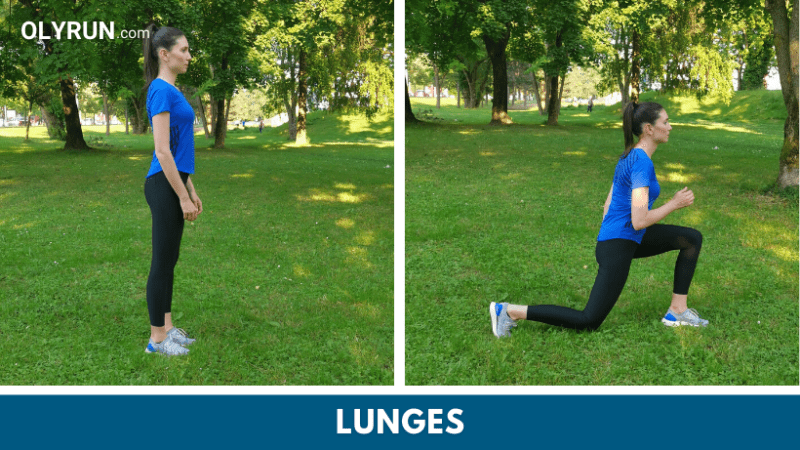
How to properly do lunges?
- Stand in the starting position so that your feet are hip-width apart, look straight ahead, and keep your upper body straight.
- Step with your left foot flat on the floor, lowering your right knee half an inch from the floor.
- Push off with your left foot to return to the starting position.
- Step with your right foot flat on the floor, lowering your left knee half an inch from the floor.
- Repeat the movement until the end of the exercise.
Advice for doing lunges
- Check your posture – keep your body straight, and don’t bend or twist your upper body.
- There are numerous versions of lunges, such as side lunges, back lunges, walking lunges, and others.
- For a more difficult version of this exercise, use a resistance band or weights.
16. Wall sit
This exercise activates your glutes, quadriceps, and hamstrings.
How to properly do the wall sit exercise?
- Get into the starting position, sitting next to a wall so that your legs are bent at the knee at a right angle, with your whole back resting on the wall. Legs are slightly apart and the whole foot is on the floor.
- Tighten your muscles and hold this position for about 30–60 seconds.
Advice for doing the wall sit exercise
- Check your posture – your thighs must be parallel to the surface.
- Don’t forget to breathe – it is extremely important to breathe during the whole exercise to ensure proper oxygen flow to the muscles.
- Do not get up on your toes – the whole foot must be on the floor.
17. Reverse lunge jump
This exercise activates your glutes, quadriceps, hamstrings, hip flexors, core, and calf muscles.

How to properly do a reverse lunge jump?
- Start in a lunge position, look straight ahead, and keep your upper body straight.
- Jump while lifting your left knee into the air, reflecting yourself with the right leg.
- Land on the right foot and return to the starting position.
- Repeat the movement until the end of the exercise.
- Repeat the exercise on the opposite side.
Advice for doing reverse lunge jump
- Check your posture – keep your body straight, and don’t bend or twist your upper body.
- For an easier version of this exercise, just do the basic lunge, without jumping.
- Land softly to lower the pressure on your joints.
- Focus on breathing – it is important to breathe during the whole exercise to ensure proper oxygen flow.
18. Caterpillar walk
This exercise activates your glutes, quadriceps, hamstrings, hip flexors, core, and calf muscles.
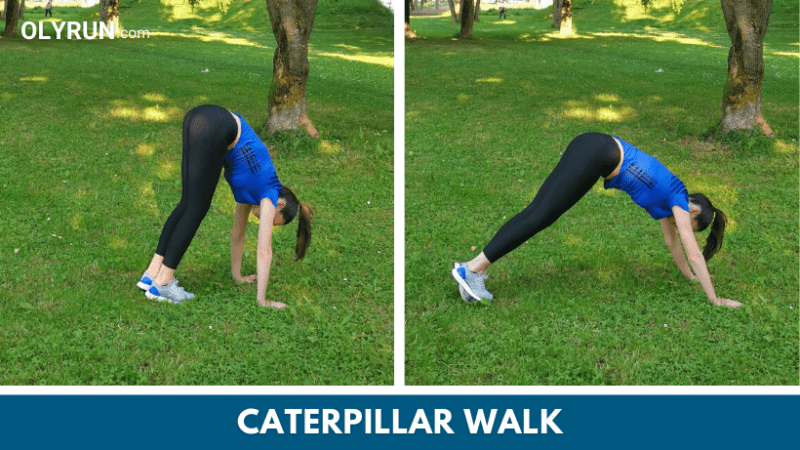
How to properly do the caterpillar walk exercise?
- Get into the starting position, bent at your hips with your palms and feet on the floor. Your feet are hip-width apart, and your arms and legs are slightly bent.
- Without moving your feet, walk forward with your hands until you come to a push-up position.
- Without moving your palms, walk forward with your hands until you come to the starting position.
- Repeat the movement until the end of the exercise.
Advice for doing the caterpillar walk exercise
- Check your form – don’t move too fast so that you can focus on the proper way of doing the exercise.
- Don’t forget to breathe – it is important to breathe during the whole exercise to ensure proper oxygen flow to the muscles.
19. One-legged heel raise
This exercise activates your calf muscles.

How to properly do one-legged heel raises?
- Get into the starting position, standing on your feet pointing forward. Your feet are hip-width apart, and your legs are outstretched. Your head, neck, and spine are straight, and you are looking straight ahead.
- Rise on the front of the left foot and tighten your muscles.
- Bring the foot flat down on the floor to the starting position.
- Repeat the movement until the end of the exercise.
- Repeat the exercise on the other side.
Advice for doing one-legged heel raises
- If you find it hard to keep your balance, feel free to hold on to a tree, wall, or pole.
- Don’t bend your legs at the knees – legs must be outstretched during the whole exercise.
- For a more difficult version of this exercise, use weights.
An example of a functional strength training workout for runners
Functional strength training includes body movements similar to those of everyday activities.
On the machines in the gym, we isolate certain muscles and, in doing so, move in an unnatural way.
Exercise overview
- Single-leg deadlift
- Push-up
- Squat
- Lunges
- One-legged heel raise
Instructions on how to perform exercises
- Before starting your workout, do a warm-up routine for at least 5 to 10 minutes. This should include dynamic stretching and mobility exercises.
- Perform each exercise for 10 to 15 repetitions, resting between each exercise as short as possible.
- Check your form during every exercise. If you aren’t able to do an exercise properly, shorten the duration of the exercise, and increase the duration of recovery.
- After you finish all five exercises, rest 60 seconds between sets, depending on your current fitness level. After that, repeat the whole set.
- If you are a beginner, do one or two sets, and if you are an advanced runner, do three or four sets.

An example of an isometric workout for runners
Isometric strength training includes exercises during which the length of the muscle and the angle of the joint do not change.
They are performed in a static position and require muscle tension without the use of movement.
Exercise overview
- Plank
- Bridge on heels
- Side plank
- Bridge
- Single leg bridge
Instructions on how to perform exercises
- Before starting your workout, do a warm-up routine for at least 5 to 10 minutes. This should include dynamic stretching and mobility exercises.
- Perform each exercise for 30 to 60 seconds, resting between each exercise as short as possible.
- Check your form during every exercise. If you aren’t able to do an exercise properly, shorten the duration of the exercise, and increase the duration of recovery.
- After you finish all five exercises, rest 30–60 seconds between sets, depending on your current fitness level and the time you have available. After that, repeat the whole set.
- If you are a beginner, do one or two sets, and if you are an advanced runner, do three or four sets.

Read more: Top 12 Isometric Exercises For Runners With Workout Example
How to warm up before strength training?
It is necessary to warm up your muscles before strength training.
If you’re doing strength training after running, then you are already warmed up and you can start doing strength exercises immediately.
And if you’re doing strength training by itself, then a 5-10-minute warm-up is necessary. The warm-up can include mobility exercises, dynamic stretches, running in place, high knees, or some other cardio exercises.
That way, you will increase blood flow and oxygen transmission to your muscles, enabling better energy production. Furthermore, you will significantly decrease the risk of injury. Muscles that are warmed up are ready for contraction and are less likely to cramp than muscles that are not properly warmed up. Warming up before a more intense activity increases their length, allowing muscles to withstand greater effort without injury.
What muscles does running work?
Running activates many muscle groups, especially leg muscles and core:
- Core muscles ensure control and stability of all movements in running.
- Hip flexors are used when lifting the legs, but also when moving the legs forward at the hip.
- Glutes play an important role in running as their role is to help you move forward.
- Quadriceps are used to extend the leg at the knee. It is also responsible for straightening and stabilizing your knees.
- Hamstrings are used to bend the knees, that is, to lift the feet towards the buttocks.
- Calf muscles are used to stretch the feet during reflection.
- Tibialis anterior muscle is used to bend the foot towards the lower leg.
- Heart sends oxygen-rich blood to cells around our body, ensuring that our body produces enough energy for muscles to work.
Read more: Key Muscles Used in Running (8 Main Muscle Groups)
How many times a week should runners do strength training?
Runners should do strength training at least two times a week.
Research has shown that it is optimal to do strength training 2 to 3 times a week over the course of 8 to 12 weeks, in order to improve the running capabilities of more advanced middle- and long-distance runners.
In any case, strength training will, aside from preventing injuries, help you build muscles that are required for you to maintain proper running form, making you a more efficient runner.
Avoid strength exercises during tapering. Reducing the amount of training before a race allows you to recover from training mentally and physically and to get to the race prepared.
Should long-distance runners do strength training?
Long-distance runners should do strength training for a number of reasons.
Strength exercises correct the muscle imbalance and improve muscle activation, reducing the risk of injury. Research has shown that the risk of injury is reduced by up to 50%.
Strength exercises improve running technique and make you run more efficiently. In other words, at the same cost of energy, you will run longer and faster. Research has shown that strength training improves your running economy by 2-8% and the overall race result (1.5–10km) by 2-5%.
Through strength exercises, you improve your neuromuscular efficiency, communication between nerves and muscles, and accelerating nerve impulses that send signals to muscle fibers. That way, your muscles become better coordinated for an intense workout or a race.
Should you do strength exercises before or after running?
If your goal is to improve endurance and aerobic threshold, then do strength exercises after running. If you want to build muscle, then you should first run and do strength training after that.
Furthermore, you can do certain strength exercises before running, as a part of a warm-up. In that case, you should do isometric exercises.
Can you do strength training at home?
You can do strength training anywhere, including your home. You do not need any additional equipment for strength training, other than a timer and an exercise mat.
In the article Best At-Home Strength Workout for Runners (Top 7 Exercises) I have shown a simple strength workout for runners that you can include in your training plan and do at home. It consists of 7 exercises and in just half an hour you can do a great workout.

How to combine running and strength training?
To take full advantage of strength training and face the next difficult running workout well-rested, it is important that you follow a couple of guidelines when putting together a training plan.
Don’t do strength training the day before a tough, high-intensity training (speed training or long run). Rather, do strength training after you finish your tough running workout.
Furthermore, don’t do strength training on rest days. It is important that you allow your body to fully recover so that you are ready for upcoming challenges.
How long should a strength training session be for runners?
For runners, strength training should last around 15 to 60 minutes, depending on your goals and training plan.
Every strength workout is adjustable according to your goals and capabilities. Therefore, if you are a beginner, you will do one or two sets of exercises and your workout will last for 15 to 30 minutes. On the other hand, if you are a more advanced runner, you will do at least three sets of exercises, and your training will last at least 30 minutes.
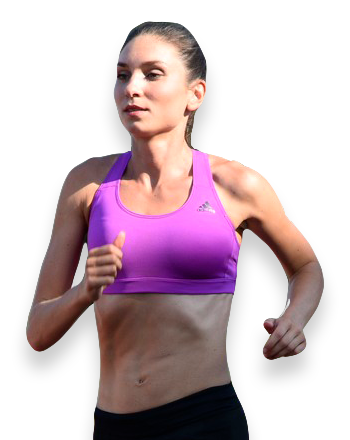
Matea Matošević
Hi, I’m Matea! I’m an Olympic Marathon Runner, founder, and writer behind OLYRUN.com. On this site, I provide help in the form of my knowledge and experience to all who love running and active living. Read more…

